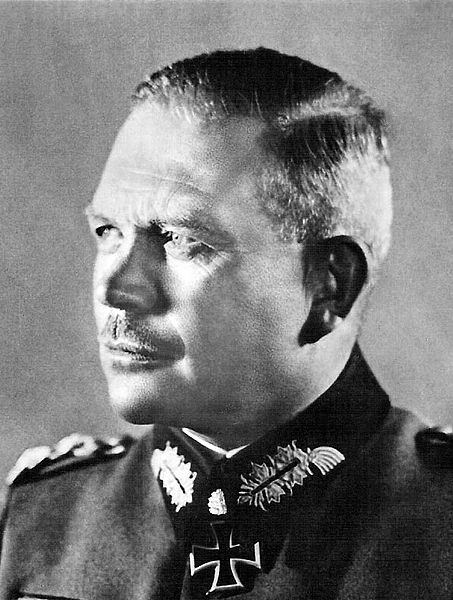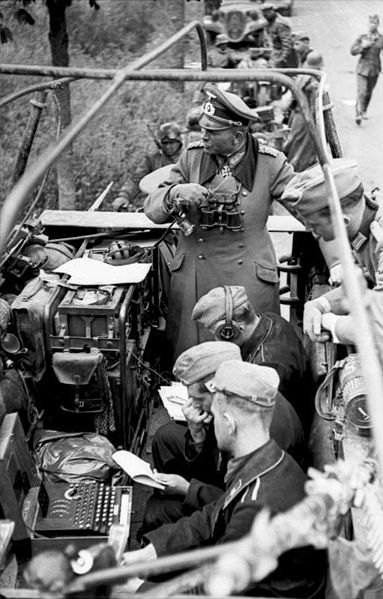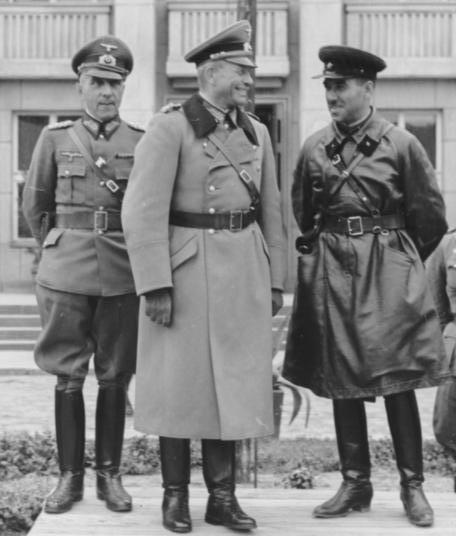<Back to Index>
- Educator and Inventor John Robert Gregg, 1867
- Composer Charles François Gounod, 1818
- Generaloberst of the German Army Heinz Wilhelm Guderian, 1888
PAGE SPONSOR



Heinz Wilhelm Guderian (17 June 1888 – 14 May 1954) was a German general during World War II. He was a pioneer in the development of armored warfare, and was the leading proponent of tanks and mechanization in the Wehrmacht (German Armed Forces). Germany's panzer (armored) forces were raised and organized under his direction as Chief of Mobile Forces. During the war, he was a highly successful commander of panzer forces in several campaigns, became Inspector - General of Armored Troops, rose to the rank of Generaloberst, and was Chief of the General Staff of the Heer in the last year of the war.
Guderian was born in Kulm, West Prussia, (now Chełmno, Poland). From 1901 to 1907 Guderian attended various military schools. He entered the Army in 1907 as an ensign - cadet in the (Hanoverian) Jäger Bataillon No. 10, commanded at that point by his father, Friedrich Guderian. After attending the war academy in Metz he was made a Leutnant (full Lieutenant) in 1908. In 1911 Guderian joined the 3rd Telegraphen - Battalion of the Prussian Army Signal Corps. In October 1913 he married Margarete Goerne with whom he had two sons, Heinz (1914 – 2004) and Kurt (born 1918). Both sons became highly decorated Wehrmacht officers during World War II; Heinz Günter became a Panzer general in the Bundeswehr after the war.
During World War I he served as a Signals and General Staff officer. This allowed him to get an overall view of battlefield conditions. He often disagreed with his superiors and was transferred to the army intelligence department, where he remained until the end of the war. This second assignment, while removed from the battlefield, sharpened his strategic skills. He disagreed with German surrender at the end of World War I, believing German Empire should continue the fight writing "the most the Allies can do is to destroy us"
After the war, Guderian stayed in the reduced 100,000 man German Army (Reichswehr) as a company commander in the 10th Jäger - Battalion. Later he joined the Truppenamt ("Troop Office"), which was actually the Army's "General - Staff - in - waiting" (an official General Staff was forbidden by the Treaty of Versailles). In 1927 Guderian was promoted to major and transferred to the Truppenamt group for Army transport and motorized tactics in Berlin. This put him at the center of German development of armored forces. Guderian, who was fluent in both English and French studied the works of British maneuver warfare theorists J.F.C. Fuller and, debatably, B.H. Liddell Hart; also the writings, interestingly enough, of the then obscure Charles de Gaulle. He translated these works into German.
In 1931 he was promoted to Oberstleutnant (Lieutenant - Colonel) and became chief of staff to the Inspectorate of Motorized Troops under Generalleutnant (Major - General) Oswald Lutz. In 1933 he was promoted to Oberst (Colonel).
During this period, he wrote many papers on mechanized warfare, which were seen in the German Army as authoritative. These papers were based on extensive war gaming without troops, with paper tanks and finally with armored vehicles.
In October 1935 he was made commander of the newly created 2nd Panzer Division (one of three). On 1 August 1936 he was promoted to Generalmajor, and on 4 February 1938 he was promoted to Generalleutnant and given command of the XVI Army Corps.
During this period (1936 – 1937), Guderian produced his most important written work, his book Achtung - Panzer! It
was a highly persuasive compilation of Guderian's own theories and the
armored warfare and combined arms warfare ideas of other General Staff
officers, expounding the use of airpower as well as tanks in future
ground combat. The German panzer forces were created largely on the lines laid down by Guderian in Achtung - Panzer! The British Army was the first to conceive and attempt armored warfare, and though British theorists were the first to propose the concept of "Blitzkrieg"
(lightning warfare), the British did not fully develop it. During World
War I, the German army had developed the idea of breaking through a
static front by concentration of combined arms, which they applied in
their 1918 Spring Offensive.
But they failed to gain decisive results because the breakthrough
elements were on foot and could not sustain the impetus of the initial
attack. Motorized infantry was the key to sustaining a breakthrough, and until the 1930s that was not possible. Soviet marshal Mikhail Tukhachevsky got the idea, but his doctrine was repudiated as contrary to Communist principles, and Tukhachevsky was executed in 1937. Guderian
was the first who fully developed and advocated the strategy of
blitzkrieg and put it into its final shape. He summarized the tactics
of blitzkrieg as the way to get the mobile and motorized armored
divisions to work together and support each other in order to achieve
decisive success. In his book Panzer Leader he wrote: In
this year (1929) I became convinced that tanks working on their own or
in conjunction with infantry could never achieve decisive importance.
My historical studies; the exercises carried out in England and our own
experience with mock-ups had persuaded me that the tanks would never be
able to produce their full effect until weapons on whose support they
must inevitably rely were brought up to their standard of speed and of
cross - country performance. In such formation of all arms, the tanks
must play primary role, the other weapons being subordinated to the
requirements of the armor. It would be wrong to include tanks in
infantry divisions: what was needed were armored divisions which would
include all the supporting arms needed to fight with full effect. Guderian
believed that certain developments in technology needed to take place
in conjunction with blitzkrieg in order to support the entire theory,
especially in communication and special visual equipment with which the
armored divisions in general, and tanks specifically, should be
equipped. Guderian insisted in 1933, within the high command, that
every tank in the German armored force must be equipped with radio and visual equipment in order to enable the tank commander to communicate and perform a decisive role in blitzkrieg.
In the Second World War, Guderian first served as the commander of the
XIX Corps in the invasion of Poland. Guderian despised Poles, calling them "dirty" "treacherous" and "half - savages" He personally led the German forces during the Battle of Wizna and Battle of Kobryn testing
his theory against the reality of war for the first time. After the
invasion he took property in the Warthegau area of occupied Poland,
evicting the Polish estate owners. In the Invasion of France, he personally led the attack that traversed the Ardennes Forest, crossed the Meuse River and broke through the French lines at Sedan.
During the French campaign, he led his panzer forces in rapid
blitzkrieg style advances and earned the nickname "Der schnelle Heinz"
(Fast Heinz) among his troops. Guderian's panzer group led the "race to the sea" that split the Allied armies in two, depriving the French armies and the BEF in
Northern France and Belgium of their fuel, food, spare parts and
ammunition. Faced with orders from nervous superiors to halt on one
occasion, he managed to continue his advance by stating he was
performing a 'reconnaissance in force'. Guderian's column was famously
denied the chance to destroy the Allied beachhead at Dunkirk by an order coming from high command. In 1941 he commanded Panzergruppe 2, also known as Panzergruppe Guderian, in Operation Barbarossa, the German invasion of the Soviet Union, receiving the 24th award of the Oak Leaves to his Knight's Cross of the Iron Cross on 17 July of that year. From 5 October 1941 he led the redesignated Second Panzer Army.
His armored spearhead captured Smolensk in a remarkably short time and
was poised to launch the final assault on Moscow when he was ordered to
turn south towards Kiev (Lötzen decision). He protested against Hitler's decision and as a result lost the Führer's confidence. He was relieved of his command on 25 December 1941 after Fieldmarshal Günther von Kluge, not noted for his ability to face up to Hitler, claimed that Guderian had ordered a withdrawal in contradiction of Hitler's "stand fast" order. Guderian was transferred to the Oberkommando des Heeres (OKH)
reserve pool, his chances of being promoted to fieldmarshal, which
depended on Hitler's personal decision, possibly ruined forever.
Guderian would deny that he ordered any kind of withdrawal.
Ironically this act of apparent insubordination is cited by his
admirers as further proof of his independence of spirit when dealing
with Hitler. Guderian's own view on the matter was that he had been
victimized by von Kluge who was the commanding officer when German
troops came to a standstill at the Moscow front in late autumn / winter
1941. At some point he so provoked von Kluge with accusations related
to his dismissal that the field marshal challenged him to a duel, which
Hitler forbade. After his dismissal Guderian and his wife retired to a 2,000 acres (8.1 km2) sequestered country estate at Deipenhof in the Reichsgau Wartheland. In September 1942, when Erwin Rommel was
recuperating in Germany from health problems, he suggested Guderian to
OKW as the only one who could replace him temporarily in Africa, the
response came in the same night: "Guderian is not accepted". Only after the German defeat at Stalingrad was Guderian given a new position. On 1 March 1943 he was appointed Inspector - General of the Armoured Troops.
Here his responsibilities were to determine armoured strategy and to
oversee tank design and production and the training of Germany's panzer
forces. He reported to Hitler directly. In Panzer Leader, he conceded that he was fully aware of the brutal occupation policies
of the German administration of Ukraine, claiming that this was wholly
the responsibility of civilians, about whom he could do nothing. According
to Guderian, Hitler was easily persuaded to field too many new tank
designs, and this resulted in supply, logistical, and repair problems
for German forces in Russia. Guderian preferred large numbers of Panzer IIIs and IVs over smaller numbers of heavier tanks like the Tiger, which had limited range and could rarely go off road without getting stuck in the Russian mud. On 21 July 1944, after the failure of the July 20 Plot in which Guderian had no involvement, Guderian was appointed chief of staff of the army (Chef des Generalstabs des Heeres) as a successor to Kurt Zeitzler,
who had departed July 1 after a nervous breakdown. During his tenure as
chief of staff, he let it be known that any General Staff officer who
was not prepared to be "a National Socialist officer" was not welcome
on that body. He also served on the "Court of Military Honour," a drumhead court - martial that expelled many of the officers involved in the July 20 Plot from the Army before handing them over to the People's Court. However,
he had a long series of violent rows with Hitler over the way in which
Germany should handle the war on both fronts. Hitler finally dismissed
Guderian on 28 March 1945 after a shouting match over the failed
counterattack of General Theodor Busse's 9th Army to break through to units encircled at Küstrin;
he stated to Guderian that "your physical health requires that you
immediately take six weeks convalescent leave," ("Health problems" were
commonly used as a facade in the Third Reich to remove executives who
for some reason could not simply be sacked, but
from episodes Guderian describes in his memoirs it is evident that he
actually did suffer from congestive heart failure.) He was replaced by
General Hans Krebs. The Enigma Machine belonging to Guderian is on display at the Intelligence Corps museum in Chicksands, Bedfordshire. Together with his Panzer staff, Guderian surrendered to American troops
on 10 May 1945 and remained in U.S. custody as a prisoner of war until
his release on 17 June 1948. Despite Soviet and Polish government
protests, he was not charged with any war crimes during the Nuremberg Trials, as his actions and behavior were thought to be consistent with those of a professional soldier. After
the war he was often invited to attend meetings of British veterans'
groups, where he analyzed past battles with his old foes. During the
early 1950s he was active in advising on the redevelopment of the West
German army: Bundeswehr. Guderian died on 14 May 1954 at the age of 65, in Schwangau near Füssen (Southern Bavaria) and is buried at the Friedhof Hildesheimer Strasse in Goslar. In 2000, a documentary titled Guderian, directed by Anton Vassil, was aired on French television. It featured Guderian's son, Heinz Günther Guderian, (who became a prominent General in the post - war German Bundeswehr and NATO) along with other notables such as Field Marshal Lord Carver (129th British Field Marshal), expert historians Kenneth Macksey and
Heinz Wilhelm. Using rarely seen photographs from Guderian's private
collection, the documentary provides an inside view into the life and
career of Guderian and draws a profile of Guderian's character and the
moral responsibility of the German general staff under Hitler.